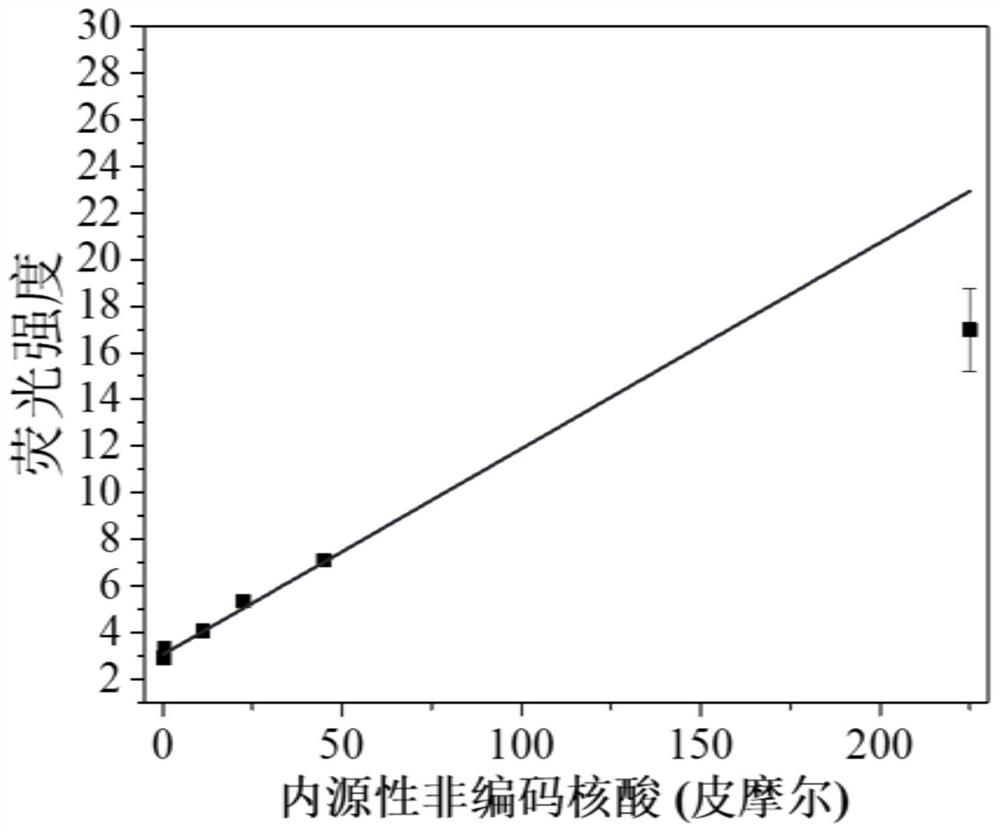a fe-based 3 o 4 @c Nanoparticle miRNA optical sensing detection method
A detection method and optical sensing technology, which are applied in biochemical equipment and methods, and the determination/inspection of microorganisms to achieve high sensitivity, enhance fluorescence recovery efficiency, and improve detection performance.
- Summary
- Abstract
- Description
- Claims
- Application Information
AI Technical Summary
Problems solved by technology
Method used
Image
Examples
Embodiment 1
[0030] Configure the determination of miRNA in water samples:
[0031] (1) Design of catalytic hairpin self-assembled nucleic acid: H1 is designed as the main body, H2 is used as the signal molecule, H3 modified amino group is covalently coupled to Fe 3 o 4 @C Nanoparticle surface, forming quenching probes. Dilute the substrate chains H1, H2 and H3 with different sequences to 43μM, 150nM and 100nM, respectively, put them in a water bath, heat to 95°C, keep for 5-10min, and then cool naturally to room temperature;
[0032] (2) Preparation of quenching probe: Fe 3 o 4 Mix @C nanoparticles and EDC at 4-50°C for 20min; then add NHS, in which Fe 3 o 4 The ratio of the mass of @C nanoparticles, the mole of EDC and the mole of NHS is 0.02g:0.0004mol:0.0001mol; after mixing, under the condition of 4-50℃, Fe 3 o 4 Activation of @C nanoparticle surface groups for 1 h; activated Fe 3 o 4 Mix @C nanoparticles with H3 and incubate at 4-50°C for 24h to form a covalent coupling to f...
Embodiment 2
[0040] Determination of intracellular miRNA:
[0041] (1) Design of catalytic hairpin self-assembled nucleic acid: H1 is designed as the main body, H2 is used as the signal molecule, H3 modified amino group is covalently coupled to Fe 3 o 4 @C Nanoparticle surface, forming quenching probes. Dilute the substrate chains H1, H2 and H3 with different sequences to 43μM, 150nM and 100nM respectively, put them in a water bath, heat to 95°C, keep for 5-10min and then cool to room temperature naturally.
[0042] (2) Preparation of quenching probe: Fe 3 o 4 Mix @C nanoparticles and EDC at 4-50°C for 20min; then add NHS, in which Fe 3 o 4 The ratio of the mass of @C nanoparticles, the mole of EDC and the mole of NHS is 0.02g:0.0004mol:0.0001mol; after mixing, under the condition of 4-50℃, Fe 3 o 4 Activation of @C nanoparticle surface groups for 1 h; activated Fe 3 o 4 Mix @C nanoparticles with H3 and incubate at 4-50°C for 24h to form a covalent coupling to form a quenching pro...
PUM
 Login to View More
Login to View More Abstract
Description
Claims
Application Information
 Login to View More
Login to View More - R&D
- Intellectual Property
- Life Sciences
- Materials
- Tech Scout
- Unparalleled Data Quality
- Higher Quality Content
- 60% Fewer Hallucinations
Browse by: Latest US Patents, China's latest patents, Technical Efficacy Thesaurus, Application Domain, Technology Topic, Popular Technical Reports.
© 2025 PatSnap. All rights reserved.Legal|Privacy policy|Modern Slavery Act Transparency Statement|Sitemap|About US| Contact US: help@patsnap.com



